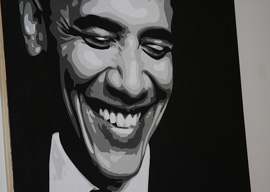
September 12, 2012

President Obama
In a 2008 interview Roth had asserted that The Human Stain wasn”t based on anyone, that he “knew Anatole slightly, and I didn’t know he was black.” But now Roth admits that way back in 1958, after throwing a football around on the beach with Broyard:
Before I left the beach that day, someone told me that Broyard was rumored to be an “octoroon.”…It’s not impossible that I had to look it up in the dictionary later to be sure of its precise meaning.
In other words, Roth first heard that his cool new acquaintance may have been passing 42 years before he published The Human Stain. And when he heard that gossip, Roth may have been intrigued enough to look up “octoroon.”
What about Roth’s candidate for the original of Coleman Silk, Princeton professor Mel Tumin? The Tumin incident certainly sounds plausible. The absurd persecution of poor Professor Tumin in 1985 may have been one of the precipitating incidents in various Jewish intellectuals” rebellion against political correctness in the late 20th century. Unlike Tumin’s friend Bellow, who converted to neoconservatism, Roth is widely assumed to be a respectable Nixon-hating liberal. Yet his loathing for political correctness is admirable. For example, Slate has a fun story about Roth denouncing feminists at Bard College as incipient Stalinists.
Today in 2012, conservatives have largely given up on protesting political correctness in return for accusing liberals of racism and other sins. But this ploy misses the point that the chief drivers of American cultural and intellectual life are highly antagonistic Jewish writers such as Roth and David Mamet. They are going to be mad at somebody, so better that they be angry at political correctness than at conservatives!
On the other hand, Roth’s assertion that Tumin was also the inspiration for Coleman Silk’s secret racial identity sounds like one of his more contrived flights of authorial whimsy:
[N]ot a few people had wondered if, because of certain seemingly Negroid features”his lips, his hair, his skin tone”Mel Tumin, who was adamantly Jewish in the overwhelmingly Waspy Princeton of his era, might not be an African-American passing for white. This was another fact of Mel Tumin’s biography that fed into my early imaginings of “The Human Stain.”
Maybe, but in the picture of Professor Tumin on the Internet, he looks like a rabbi’s son.
So should Wikipedia trust the novelist, even when the author is a notorious metafictional leg-puller?
Trust, but verify.
I asked Zach Tumin, Melvin’s son, who leads Harvard Kennedy School’s project in Information and Communications Technology and Public Policy. He replied:
Our family is of east European Jewry – Rumanian descent on my father’s side, and darkly complected. My father’s father Reuven, and his father Avram, were as I understand it both rabbis.
So Mel Tumin wasn’t passing, but Roth’s assertion that Tumin’s skin tone inspired rumors can hardly be rejected.
The younger Tumin, who might be the best independent source, confirms Roth’s account:
The story as recounted by Roth in his New Yorker open letter is consistent with the facts as I know them.
Moreover, it’s appears likely from internal evidence that Roth wasn’t drawing much from Broyard even as a second source of inspiration.
In Roth’s defense, it’s likely he wasn”t thinking much about Broyard. He didn’t seem to do any research at all on Broyard’s background, which is crucial to his tale. As Broyard’s French name suggests, the critic was more or less a “creole of color” from New Orleans, where the American one-drop rule was an alien cultural import out of sync with some of the locals’ more Latin views on racial mixture. Instead of a color line, there had long been an informal color continuum.
A half-century ago, however, this Latin approach went out of fashion and was replaced by an ideology of black solidarity that now embraced the one-drop rule.
For example, there was a hit Broadway musical in 1992 called Jelly’s Last Jam, which castigated early New Orleans jazz legend and creole of color Jelly Roll Morton for not calling himself black.
Members of the mixed-race castes began changing their self-image from Not Really Black to the Natural Leaders of Blacks just as white America was switching from despising to subsidizing blacks. Thus, several of the “black” mayors of New Orleans, such as the Morial family, have been creoles of color who could be said to be “passing” as black.
Similarly, as the Hawaiian-born preppie Obama documents in Dreams from My Father, he had to strive for years to make himself black enough to reap the rewards.